My boss, Carl Wieman, likes to describe what we do as “looking for the pattern of how people learn science” (as he does in this video.) And the places to look are classroom studies, brain research and cognitive psychology. I certainly agree with the first place – that’s teachers and teaching. And research like this, that and this other thing about how the brain physically changes while you learn in very cool – that’s science. But cognitive psychology? I’ve been a science geek since, well, since before I can remember anything else, so I really haven’t been exposed to psychology and those other disciplines they teach on the “Arts” side of campus.
Carl says it’s important, though, and I trust him, so my colleagues and I read a cognitive psychology paper for our CWSEI Reading Group “What College Teachers Should Know About Memory: A Perspective From Cognitive Psychology” by Michelle D. Miller (College Teaching, 59, 3, 117, (2011)). Here’s a link, if you have access from where you’re clicking.
The paper is a nice summary of the models of memory. Short term, long term, working memory, ecological (or adaptive) memory. Here’s my interpretation. Every bit of information that’s stored in memory is accompanied by “cues”. Think “tags”, like the ones that accompany this blog post. When you see the cues, you recall the memory, just like finding blog posts by clicking on a tag. Without the tags, finding posts means paging through the archive. With a tag, you can zero in on the post. And the more tags on the post, the easier it is to find. Same with memories: the more cues linked the memory, the easier it will be to recall later.
Not all cues are created equal, though. As Miller puts it,
[u]nderstanding the role and importance of cues enables a richer and more accurate understanding of why people remember — and forget — what they do. (p.119)
Miller carefully crafted descriptions of the kinds of cues that trigger recall, so while I’m cutting them into a list and adding some bold, these are Miller’s words (p. 120):
Here are what I believe to be the cues that trigger us to “tag” information as being survival-relevant:
sensory impact, termed vividness: Concrete information that comes accompanied by sound, visual qualities, even tactile sensation tends to be more memorable than abstract information. Visual information is particularly salient to human beings, so that anything that can be visualized tends to be particularly memorable.
emotional impact is another cue that incoming information warrants long-term storage. Consider situations that relate to survival in a “natural” setting—a sudden danger, a new food source, encountering an enemy—and all would come accompanied with an emotional “charge.”
relevance to one’s own personal history is another indication that information will be useful in the future
structure and meaning—the ability to interpret information and put it into context—helps us distinguish useless background clutter from information that we need to keep
personal participation, as contrasted with passive exposure. This will come as no surprise to those familiar with the “active learning” trend. If we watch someone else do something, that activity may or may not be relevant to us, and it we will likely opt not to form a detailed memory of it. However, if we ourselves carry out the action, there is a greater likelihood that we will need to learn from and recall that experience later. We may also encode a richer set of cues when we are actively involved, which increases the likelihood of retrieving the information later.
Don’t you love it when you read an article that concisely and explicitly describes all those things you feel, in your gut, are important? It’s times like this that make me re-evaluate my naive and, frankly, prejudiced view of psychology, “C’mon, how can you possibly know how humans work?” “Oh, like that, ” he says, sheepishly. “Um, thanks. That’s cool!”
The week my colleagues and I read this paper, I was preparing the next activity for an introductory, general-education astronomy course I work on. This activity, like the others I’ve written and am sharing through the Astro Labs page on this blog, is a chance for “Astro 101” students to get some hands-on interaction with astronomy. Up next was the activity on black holes, especially spaghettification.
“Spaghettification”?
Talk about a made-up word, huh. Not by me, mind you. Chat with any astronomy instructor and you’ll find we all know exactly what it means because it’s the perfect word to describe what happens if you fall into a black hole.
<astronomy lesson>
A black hole with the mass of the Earth would only be about the size of a grape. Imagine it this way: if you could pack together and compress the entire Earth down to the size of a grape, the force of gravity would be so strong curvature of spacetime would be so high that not even light, traveling outwards as the speed of light, could escape.
That describes trying to get out a black hole. What about falling in? Let’s imagine you’re 2 metres tall and your lying on your back with your feet 2 metres from the black hole and your head 4 metres from the black hole. You can see it down there, between your feet, a little shiny grape a couple of metres away. It’s okay to think classically here, for a moment. Gravity is very strong but, being an inverse square law, it drops off quickly: your head is 2 times farther from the black hole than your feet so the force of gravity is only 1/4 as strong. What do you suppose happens when the black hole pulls 4 times harder on your feet? They get ripped off, that’s what. Your body gets stretched out as your feet accelerate towards the black hole, leaving your knees, hands, chest and head behind. This difference-in-forces is called a tidal force because these same kinds of forces occur in the Earth-Moon system where the Moon yanks on the water on Earth’s near-side and leaves the far-side water behind, giving us the tides. Newton worked that one out for us, more than 300 years ago.

The force of gravity between the Moon and the water on the near-side of the Earth is stronger than the force between the Moon and the more distance, far-side water. Earth's watery skin is deformed, giving us the tides. (Graphic: Peter Newbury CC)
Meanwhile, back at the black hole, the hapless astronaut is being pulled down a little funnel that ends up on the grape-sized black hole. Happy astronaut one second, long and skinny piece of spaghetti the next. Spaghettification, baby!
</astronomy lesson>
Ouch, that’s gotta hurt! LOL. Yeah. But how do we get Astro 101 students to remember it a month from now on their exam? Play-Doh, that’s how. Our activity progresses from setting up the phenomenon of tidal forces, to sample calculations demonstrating tidal forces are real, to recreating the spaghettification of a Play-Doh astronaut.
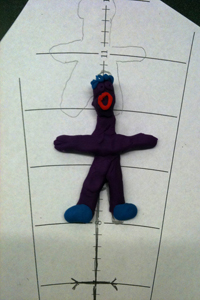
An astronaut falling into a black hole, before spaghettification...
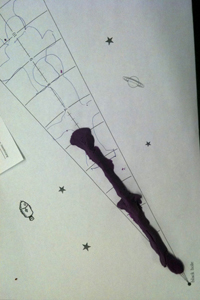
...and after!
Here’s where the part about memory comes in. Students are potentially reluctant to play with Play-Doh. This is University. We’re not Children anymore. Teaching assistants and instructors are equally reluctant to ask students to play with Play-Doh. “Why,” they wonder, “should I?”
Because, I tell the teaching assistants who, if necessary, relay it to the students, it will help you remember. Playing with Play-Doh, stretching the poor astronaut’s legs, often pulling them right off his body, and squishing the Play-Doh into to a narrow strip, is tactile. And emotional – you just ripped his head off, dude! It gives relevance and a physical structure to those calculations. And it takes personal participation – oops, I just pulled his leg off!
Good in theory but how about in practice? The activity ran. The teaching assistants sold it. The students did it. All of them! Now we just have to see if they (1) learned anything and (2) can remember it. For (1), one of the questions they answer at the end of the activity is, “In your own words, describe what happens to the astronaut. Why do you think it’s called ‘spaghettification’?” Here’s one student’s answer, typical of many I thumbed through:
as the astronaut falls toward the black hole, feet first, its body stretches as it nears the black hole. the closer body parts (feet, then hands) stretch faster and fall faster than the head and body. It’s called spaghettification because the legs and hands stretch elongate like spaghetti.
Yep, I’ll take that. Would have been nice to see the word “tidal” in there but he did make the connection between closer and faster. For (2), we’ll be sure to put something on the final exam that tests this material. I’ll let you know in 4 weeks.
As my pop likes to say, “learn by doing.” Let’s update that to, “remember by doing.”
 What have I said in 10,000 tweets? I discovered Twapperkeeper about 6500 tweets ago so pushing that archive through Excel, grep (with excellent help from @aquillam and @anthonyfloyd) and Wordle, there are a few words that stand out:
What have I said in 10,000 tweets? I discovered Twapperkeeper about 6500 tweets ago so pushing that archive through Excel, grep (with excellent help from @aquillam and @anthonyfloyd) and Wordle, there are a few words that stand out: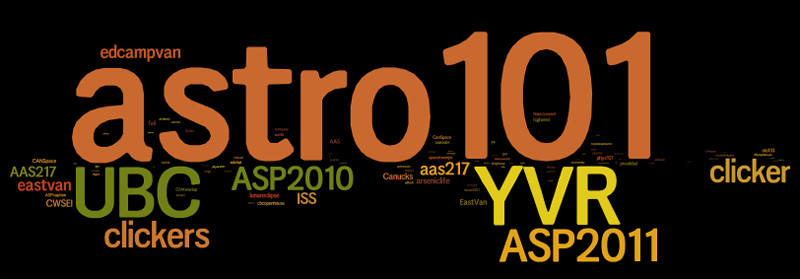

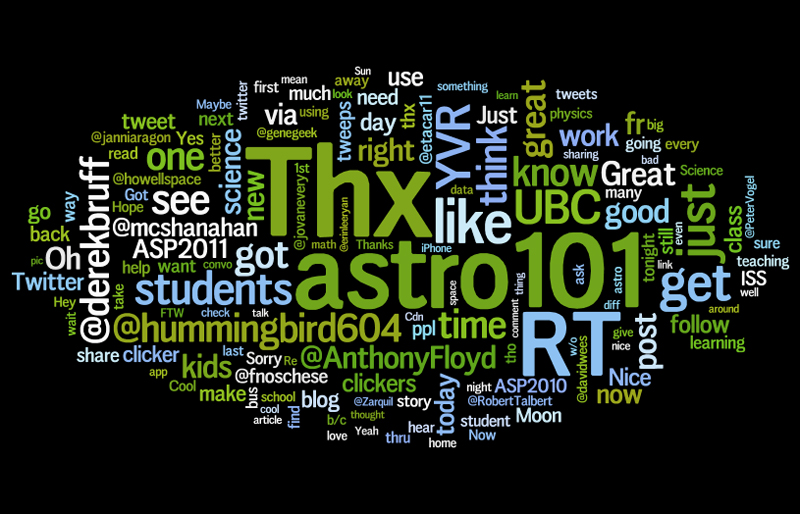
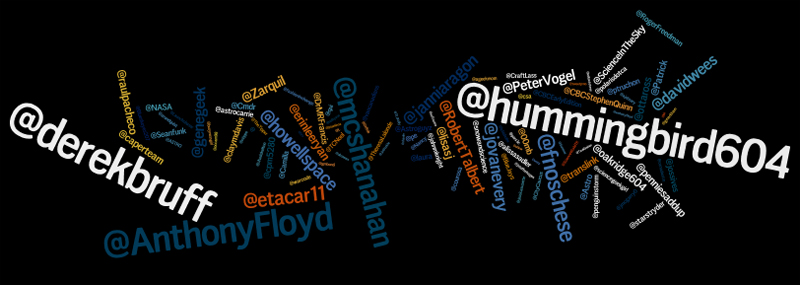




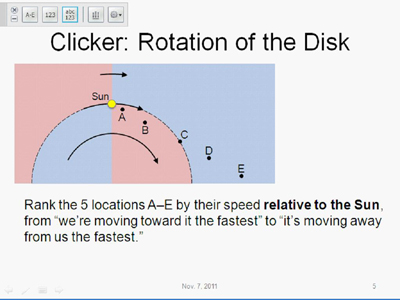
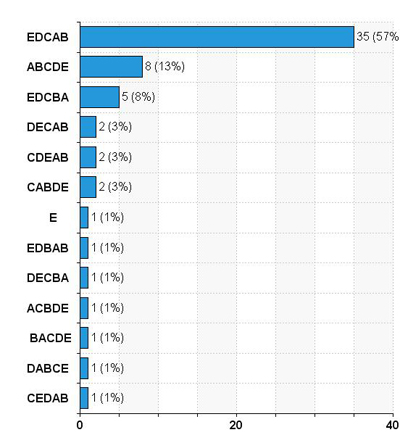
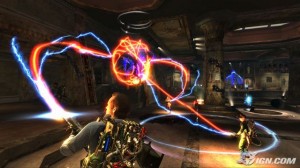

 I still ask questions. A lot of them. One of my role models is Simplicio from Galileo’s
I still ask questions. A lot of them. One of my role models is Simplicio from Galileo’s